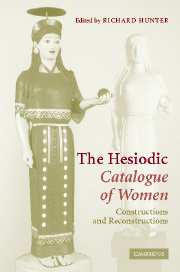Book contents
- Frontmatter
- Contents
- Notes on contributors
- Acknowledgements
- List of abbreviations
- Introduction
- 1 Ordering women in Hesiod's Catalogue
- 2 The beginning and end of the Catalogue of Women and its relation to Hesiod
- 3 Gods among men? The social and political dynamics of the Hesiodic Catalogue of Women
- 4 Heracles in the Hesiodic Catalogue of Women
- 5 Mestra at Athens: Hesiod fr. 43 and the poetics of panhellenism
- 6 A catalogue within a catalogue: Helen's suitors in the Hesiodic Catalogue of Women (frr. 196–204)
- 7 Pulp epic: the Catalogue and the Shield
- 8 The Megalai Ehoiai: a survey of the fragments
- 9 Ordered from the Catalogue: Pindar, Bacchylides, and Hesiodic genealogical poetry
- 10 The Hesiodic Catalogue and Hellenistic poetry
- 11 From genealogy to Catalogue: the Hellenistic adaptation of the Hesiodic catalogue form
- 12 The Hesiodic Catalogue of Women and Latin poetry
- 13 Or such as Ovid's Metamorphoses …
- Bibliography
- Index of passages discussed
- General index
9 - Ordered from the Catalogue: Pindar, Bacchylides, and Hesiodic genealogical poetry
Published online by Cambridge University Press: 22 September 2009
- Frontmatter
- Contents
- Notes on contributors
- Acknowledgements
- List of abbreviations
- Introduction
- 1 Ordering women in Hesiod's Catalogue
- 2 The beginning and end of the Catalogue of Women and its relation to Hesiod
- 3 Gods among men? The social and political dynamics of the Hesiodic Catalogue of Women
- 4 Heracles in the Hesiodic Catalogue of Women
- 5 Mestra at Athens: Hesiod fr. 43 and the poetics of panhellenism
- 6 A catalogue within a catalogue: Helen's suitors in the Hesiodic Catalogue of Women (frr. 196–204)
- 7 Pulp epic: the Catalogue and the Shield
- 8 The Megalai Ehoiai: a survey of the fragments
- 9 Ordered from the Catalogue: Pindar, Bacchylides, and Hesiodic genealogical poetry
- 10 The Hesiodic Catalogue and Hellenistic poetry
- 11 From genealogy to Catalogue: the Hellenistic adaptation of the Hesiodic catalogue form
- 12 The Hesiodic Catalogue of Women and Latin poetry
- 13 Or such as Ovid's Metamorphoses …
- Bibliography
- Index of passages discussed
- General index
Summary
CATALOGUE AND PRAISE
Greek lyric poets of the early fifth century largely addressed local audiences while promising panhellenic renown. The context of their songs is inscribed in the texts themselves. The interplay between local concerns (the poet's, the patron's and the audience's) and the more than local reach of the song was a complex construct. By contrast, genealogical epic poetry, as we are able to reconstruct it, does not seem explicitly to have addressed any specified local audience. Its main subject was indeed local traditions, but they had to be adjusted to a panhellenic frame. It is not unlikely that local bias may have directed the poet's choices, but, when this happened, it did not leave any overt mark on the text. Modern critics are not unanimous about the existence of a political ‘hidden agenda’ behind the remains of the Hesiodic Catalogue, and it is not unlikely that our uncertainty would not have changed very much had the poem been entirely preserved.
Inserting somebody as one of many items in a catalogue may not appear as a very flattering rhetorical strategy. The catalogue of Zeus' lovers in his speech to Hera (Iliad 14.312–28) culminates with his wife as the best item in the series, the climax which surpasses those who have gone before. It is not surprising, however, that most readers have found his move rather tactless.
- Type
- Chapter
- Information
- The Hesiodic Catalogue of WomenConstructions and Reconstructions, pp. 217 - 238Publisher: Cambridge University PressPrint publication year: 2005
- 8
- Cited by

